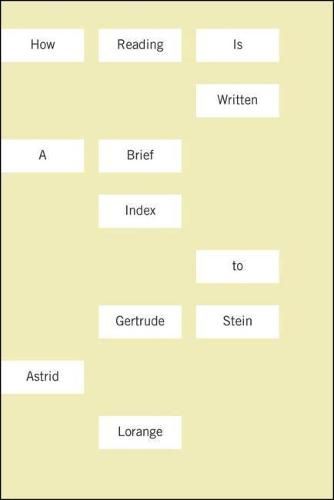Readings Newsletter
Become a Readings Member to make your shopping experience even easier.
Sign in or sign up for free!
You’re not far away from qualifying for FREE standard shipping within Australia
You’ve qualified for FREE standard shipping within Australia
The cart is loading…






Gertrude Stein is a seminal figure in modern and postmodern literature, yet her work is not easily defined and has had both fierce supporters and equally fierce detractors. In a series of linked essays, How Reading Is Written considers a set of questions associated with reading Gertrude Stein today. In particular, how can we read a body of work that is largely resistant to conventional and interpretation-based models of literary criticism? The book is structurally and conceptually an index to Stein’s poetics, and it considers Stein alongside other writers and thinkers, and across discourses of philosophy, science, queer theory, and literary criticism. Like Charles Olson’s Call Me Ishmael and Susan Howe’s My Emily Dickinson, How Reading Is Written joins a tradition of books by poets about the writers who have intensely figured into their conception of poetry. Astrid Lorange recovers previously overlooked critical work on Stein and aims to construct a new intellectual episteme for Stein’s work-one that connects with contemporary contexts as well as repositions Stein in her moment of transnational modernism.
$9.00 standard shipping within Australia
FREE standard shipping within Australia for orders over $100.00
Express & International shipping calculated at checkout
Gertrude Stein is a seminal figure in modern and postmodern literature, yet her work is not easily defined and has had both fierce supporters and equally fierce detractors. In a series of linked essays, How Reading Is Written considers a set of questions associated with reading Gertrude Stein today. In particular, how can we read a body of work that is largely resistant to conventional and interpretation-based models of literary criticism? The book is structurally and conceptually an index to Stein’s poetics, and it considers Stein alongside other writers and thinkers, and across discourses of philosophy, science, queer theory, and literary criticism. Like Charles Olson’s Call Me Ishmael and Susan Howe’s My Emily Dickinson, How Reading Is Written joins a tradition of books by poets about the writers who have intensely figured into their conception of poetry. Astrid Lorange recovers previously overlooked critical work on Stein and aims to construct a new intellectual episteme for Stein’s work-one that connects with contemporary contexts as well as repositions Stein in her moment of transnational modernism.